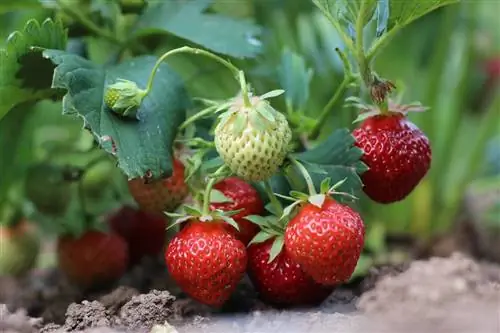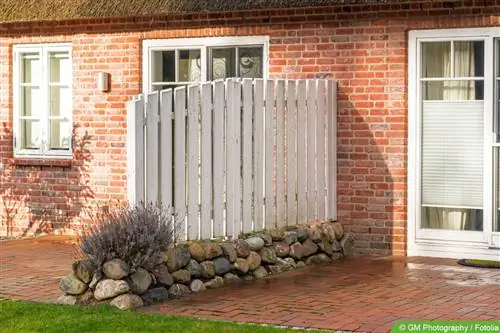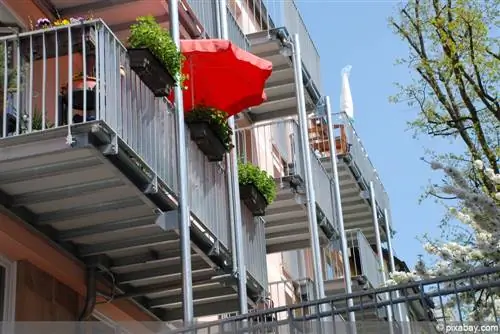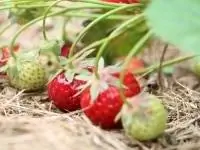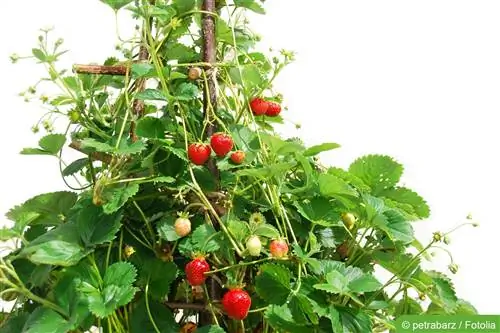- Author admin [email protected].
- Public 2023-12-17 03:39.
- Last modified 2025-01-24 12:45.
The German's favorite fruit is probably the strawberry. It's sweet as sugar and otherwise super delicious. All the better that cultivation is so uncomplicated as long as you pay attention to a few things.
Site conditions
Strawberries are real sunshine children. In order to be able to develop many delicious fruits, they need a place that is protected from wind and rain and, above all, sunny. The location on the balcony should still be airy. The conditions are usually optimal on a south-facing or south-west balcony. But you don't have to miss out on enjoying strawberries even in semi-shady locations, because wild and monthly strawberries also thrive there.
Soil texture
When choosing the substrate, you should know that strawberries are among the so-called heavy feeders. Consequently, the soil should be nutrient-rich. Normal standard soil is just as suitable as potting soil, perennial soil or potted plant soil. Aggregates such as perlite or expanded clay are very welcome. They store water and slowly release it to the plant. You should avoid bark mulch and, for the sake of the environment, you should also avoid peat.
The right planter
When choosing the right planter, it is important that it is large enough so that the strawberry plants can develop well. The fine roots are mainly located in the upper 15 cm of the pot. Therefore, for a single plant, it should have a depth of at least 15 cm and a diameter of 12-15 cm.
Square containers with a size of 30 x 30 cm or flower boxes with a length of 60, 90 or 120 cm are suitable for several specimens. Numerous variants are available commercially. There are constructions with several plant levels or so-called strawberry towers for hanging and climbing varieties.
Tip:
If space on the balcony is limited, climbing and hanging strawberries are ideal.
Best planting time
The right time to plant depends on the variety. The best planting time is between mid/late July and mid-August. Varieties that bear ever or more often are planted from August to September. An exception are so-called frigo plants, which are cleared between November and February and stored at minus two degrees. They can be planted almost all year round, i.e. from March to September. It is not uncommon that they only consist of rhizomes and roots and bear fruit that is ready to harvest after just eight weeks.
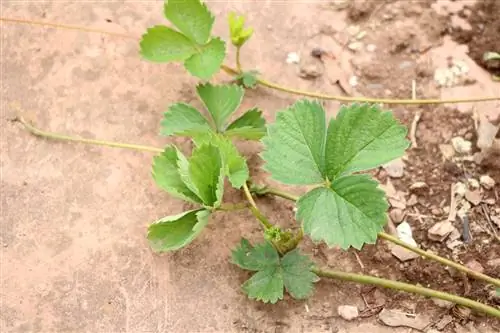
Gaining young plants
Strawberry plants continually form long runners with small offshoots that are perfect for planting. Offshoots that are not needed for propagation should be cut off close to the mother plant as soon as they are discovered. If you don't do this, they rob the plant of a lot of strength, which in turn has a detrimental effect on flower formation and consequently also on fruit.
Tip:
If you don't have your own plants, you can buy strong young plants from garden centers, hardware stores or garden centers from early spring onwards.
Planting instructions
For your own offshoots
- fill a small pot with good potting soil
- Select cuttings from a particularly productive plant
- place on the soil in the pot
- do not separate from the mother plant yet
- fix to the ground with a wire
- only cut the connection to the mother plant after root formation has taken place
- pot into good potting soil
- one plant takes up about 30 cm of space
- Administer organic strawberry fertilizer at the end of the season
Purchased young plants
- Fill planters with soil two weeks before planting
- Water the soil afterwards
- leave to set until planting
- If necessary, add half a teaspoon of strawberry fertilizer
- water bare-rooted plants a few hours before planting
- then loosen the roots a little and plant them
- also water potted specimens briefly
- Planting distances of around 25 cm are recommended
- Press soil lightly, water in
Tip:
When planting, the root neck of the young plant should be flush with the ground so that the heart is exposed. If it sits too low, there is a risk of rot; if it is too high, the heart can dry out, leading to total failure.
Subsequent care
- water thoroughly immediately after planting
- Make sure you have enough water for the next two to three weeks
- water regularly from flowering to fruiting
- the more frequent the smaller the planter is
- at best, always water in the morning
- Mold in the pot and on the leaves is so avoidable
- Empty coasters and planters regularly
- Fertilize single-bearing varieties after harvest in August
- wearing several times in spring and autumn
- with compost, horse manure or special berry fertilizer
- Remove weeds regularly
- cut off excess runners or offshoots
Tip:
If you combine different varieties, for example double and ever-bearing varieties, you have something to snack on all summer long.
Mulching in hot summers
In particularly hot and dry summers, it is advisable to mulch the soil around the strawberry plants with hay, straw or dried grass clippings. On the one hand, the mulch keeps the moisture in the soil longer and on the other hand, it protects the fruits from moisture and therefore also from rot. However, it is important to ensure that the layer is not too dense and that the plant continues to be well ventilated all around. Comfrey leaves are also very suitable for mulching. The potassium it contains allows the fruits to ripen better, strengthens the cell tissue and makes the plants more resistant to diseases and pests.
Replace plants every three years
Strawberry plants generally produce best in their second year. After three years, the yields decrease significantly and the fruits become smaller from year to year. For this reason, it is advisable to replace them with fresh young plants every three years. Many replace them after the second year. Of course, the earth should also be renewed.
Winter protection for balcony strawberries
In the garden, strawberries do not require any winter protection. The situation is different with plants in pots, tubs or flower boxes. They should be cut back in late fall when the strawberry season comes to an end. Both leaves and runners are removed. The purpose of this measure is to prevent fungal infection, as the leaves are susceptible to red and white spot disease. The heart of the plant should be preserved.
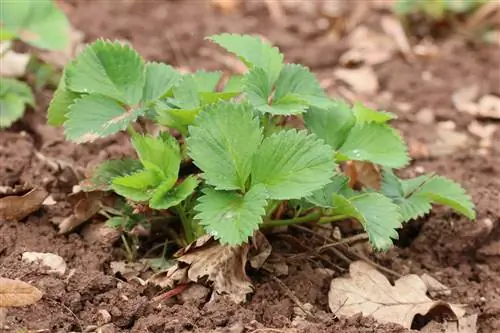
The pot or flower box is then placed in a protected place near the house on a wooden pallet or Styrofoam plate. A covered spot is ideal. To protect the root area from freezing, protect the pot from the outside and below with cold-insulating materials such as fleece or bubble wrap and also cover it with brushwood, straw or mulch.
Measures to increase yield
Since the space available on most balconies is rather limited, there is a lot you can do to get the best out of your plants and increase yields. And all without much effort.
- Remove long, leafless runners regularly
- unless needed for propagation
- Target flowers in the first year
- All flowers for varieties bearing in June
- Continue until the end of June if you are pregnant more often
- therefore harvest in autumn
- This strengthens plants
- Consequences are increased flower and fruit production in the second year
- Yield increase also by repotting in fresh soil in spring
- or incorporate compost into the upper substrate layer
Varieties for the balcony
‘Arabella’
- high-yielding and frost-hardy variety
- very large, easy to pick fruits
- Long harvest season from June to October
‘Tuscany’
- Variety with large decorative pink flowers
- wonderfully aromatic, sweet fruits from May to October
- also bears on the foothills
‘Cupido’
- impresses with its intense strawberry aroma
- very fruity bright red strawberry
- continuous reblooming, medium-sized fruits from May to September
‘Viva Rosa’
- pink flowers, elongated, medium-sized fruits
- blooms and bears all summer
‘Aromastar’
- large bright red fruits
- robust variety with a wonderful wild strawberry aroma
- Harvest from June
'Klettertoni'
- Climbing strawberry with deep red aromatic, juicy-sweet fruits
- Harvest from June to frost
- Trellis recommended

